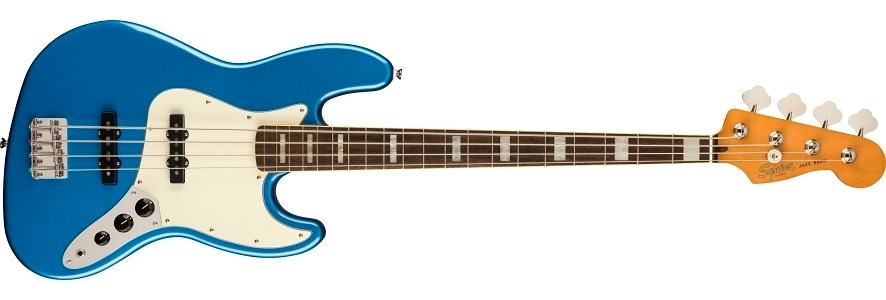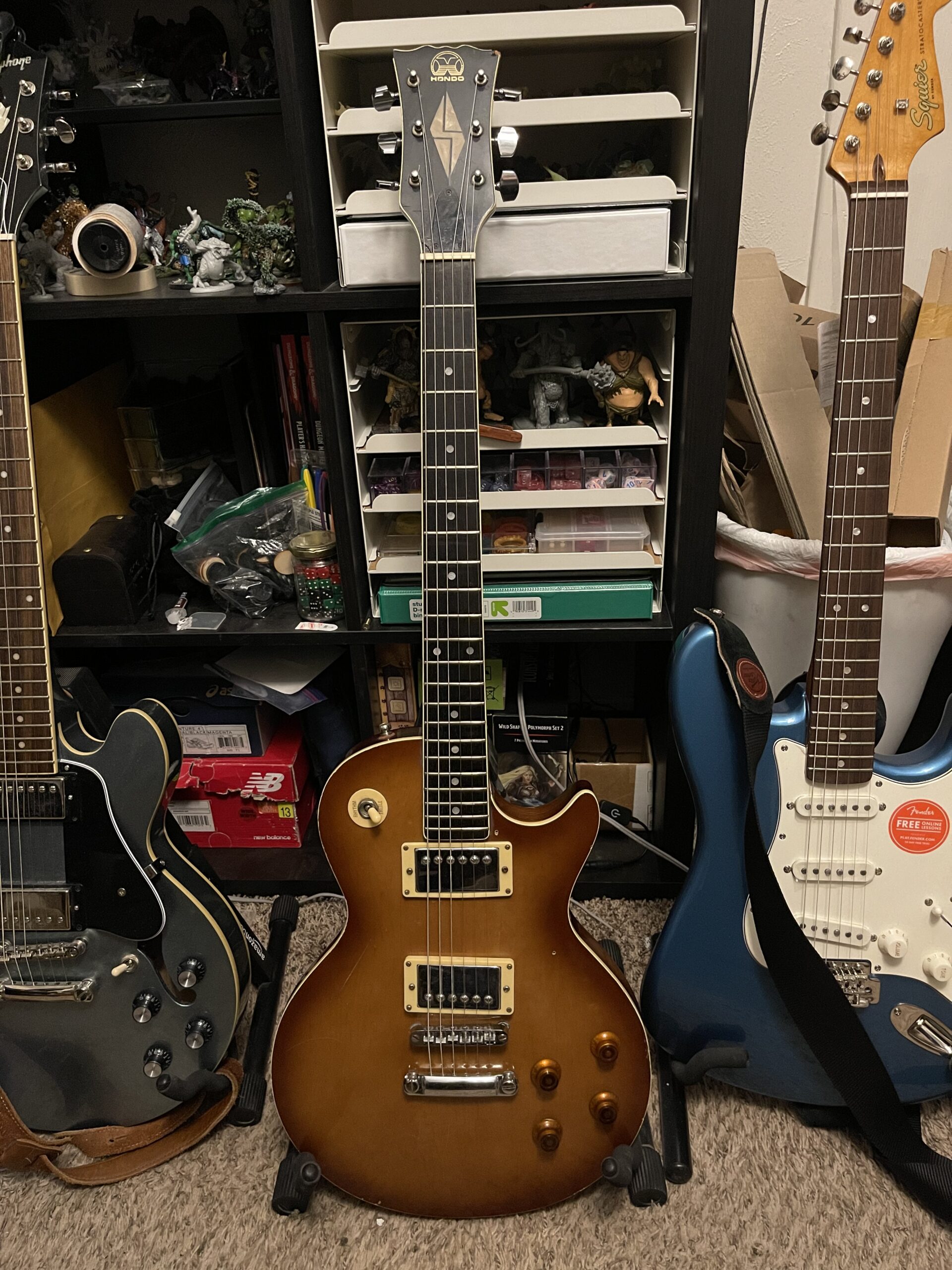I recently watched a video on Rhett Shull’s YouTube channel about one amp for everything. At the start of that video, he talks a bit about his first guitar amp and subsequent journey. Now, I’m nowhere near as interesting as a bonafide YouTuber who has chops and knows their stuff. Instead, I’m just a dude who’s owned a few guitar amps in my time.
This is going to be lengthy, and there are too many parts to make use of the tabs to save you from scrolling. Sorry about that!
Note: this post will be updated as my amps change
My First Amp – Fender R.A.D.
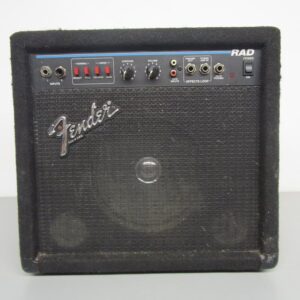 My grandmother bought me this guitar amp when she bought me my Squier Contemporary Stratocaster and I owned it until it was stolen from a church that I was helping lead worship for the college-aged group. Gotta love that, right? Stolen at church.
My grandmother bought me this guitar amp when she bought me my Squier Contemporary Stratocaster and I owned it until it was stolen from a church that I was helping lead worship for the college-aged group. Gotta love that, right? Stolen at church.
That RAD was pretty terrible. There were four red buttons on the front that enabled different modes: two for clean and two for drive. The knobs where Contour and Volume. Interestingly, it had an effects loop, something I wouldn’t fully understand until way later in life.
The amp allowed me to play my guitar, was portable enough to take anywhere, and I only know now just how terrible it likely was. I don’t actually remember what it sounded like. If given the chance, I’d likely buy another, if the price were right.
Peavey Classic/Bandit
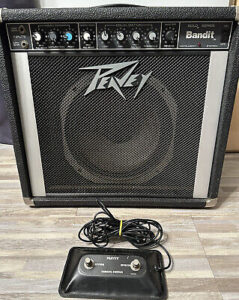 For Christmas of ’94 or ’95 (maybe ’96), my mother bought me a Peavey Classic amp. At that time, I didn’t want anything to do with tubes. What? I had always been told that they were too much trouble for a beginner like me, and I stupidly made her return it. Instead, I opted to buy a Peavey Bandit at a local music store.
For Christmas of ’94 or ’95 (maybe ’96), my mother bought me a Peavey Classic amp. At that time, I didn’t want anything to do with tubes. What? I had always been told that they were too much trouble for a beginner like me, and I stupidly made her return it. Instead, I opted to buy a Peavey Bandit at a local music store.
Looking back, man, was I an idiot. That Classic, while not a complete tube amp, would have been so incredibly killer at that age. It would have been plenty loud, though not a lot of fun to transport, and I’d have likely owned it longer than I owned the the Bandit. What. An. Idiot.
I ended up using the Bandit in two bands during high school, Circus of Fools and Nailbox. It was loud enough to be heard over the drummers of those two bands, which was sufficient for me.
I also don’t remember why I don’t have it anymore, and anything that sounds vaguely familiar is guesswork on my part.
Fender Stage 112SE
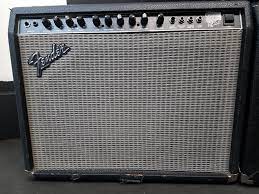 About halfway into my Senior year of high school, I received what remained of the inheritance from my uncle. It was roughly $6500, a fortune to an 18 year old. Of course, I spent it all. I went to Guitar Center and was convinced to buy a Fender Stage 112SE, an incredibly loud, dual-channel amp. Once again, I should have bought a tube amp that I’d likely have kept, but I was still in my “anti tube” stage.
About halfway into my Senior year of high school, I received what remained of the inheritance from my uncle. It was roughly $6500, a fortune to an 18 year old. Of course, I spent it all. I went to Guitar Center and was convinced to buy a Fender Stage 112SE, an incredibly loud, dual-channel amp. Once again, I should have bought a tube amp that I’d likely have kept, but I was still in my “anti tube” stage.
I used this amp for the last show that Nailbox played and would use it through at least 2000 during my Soulhitter days. When that band recorded two songs at Dallas Soundlab, I took that amp into the studio. Listening back to those two songs, it was a solid enough clean and drive tone, but I attribute that to being in a proper studio.
Somewhere along the way, two knobs got broken off flush with the chassis and I abandoned that amp. I’d eventually sell it back in my earliest days of Craigslist posting experiences for about $100. Hopefully, the dude that bought it was able to repair the pots. Seems like it’d be an easy repair.
While the 112SE is a solid state amp, I’m curious how I’d like it nowadays as a clean pedal platform. It’s far too loud for what I do now. I’d never BUY one, but if I had the chance to play one and put it through its paces, I’d do it. Throw a couple of my favorite pedals at it.
Fender Roc Pro 1000 Head and Sovtek 4×12 Cab
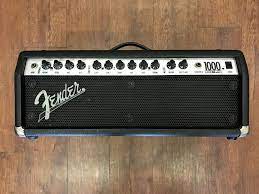
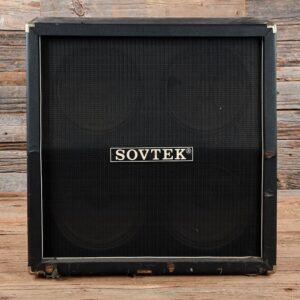
At one point, a friend of mine were pawnshopping before work one day and came across a cheap 4×12. I want to say it was $80. I needed a head and eventually found a Roc Pro 1000 at another pawn shop. That friend and I would later record a few songs at my house and we used that. That was 2004, but we worked at the place that would have put us near that initial pawn shop in 1999. I don’t know the exact timing.
At this point, I thought I was a legit guitar player. I had a head and cab. Like the Stage 112SE, this was LOUD. Too loud for my grandmother, and as I lived in her house, I’d really just play it when she was gone. My neighbors hated me. I want to say I still had my Fender RAD, so that saw more use than the Roc Pro 1000 did. However, I knew if I ever joined or started a band, I’d have volume on my side.
Eventually, I sold that Roc Pro 1000 to a man whose son was looking for that exact model. The Sovtek would stick around for quite some time and would serve as the cab for the next head I would buy.
Epiphone Valve Jr. Head
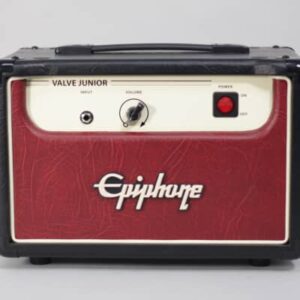
I made my first foray into tube amps/heads with this purchase. Even at 5w, at least through that Sovtek 4×12, it was loud. I wanted to get that sweet tube saturation but I had to turn it WAY up, which meant a lot of volume.
After this point, things get really hazy. I don’t remember exactly what I owned between this and the next amp.
The Valve Jr. didn’t stick around for very long. I eventually met a dude who kind of shorted me in some deals and he bought this from me. I was down to sell it because I wanted a tone control and channel switching. The Valve Jr. makes a good pedal platform becuase of its simplicity, and you can push it past the edge of breakup with the right pedal too.
Fender Deluxe Reverb Reissue
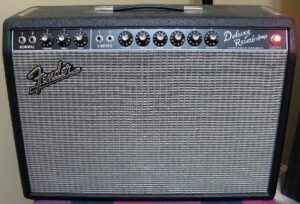
There were a handful of amps that swim into my head that I used, but I couldn’t nail down which one at a specific time. I remember owning a Crate Palomino V32, a Line 6 Spider Valve and a Marshall JTM60. The latter of which sounded great, when it worked. The dude that shorted me on some deals traded me that, and I have a feeling he was taking advantage of my lack of knowledge. That Spider Valve actually prompted me to write a number of songs in a short a mount of time before I returned it because it was too loud for an apartment. It seems like it’s not too highly thought of, but I remember really digging it.
Eventually, I’d meet up with someone on Craigslist who pointed me in the direction of The Gear Page forum back in 2007. So many people spoke quite highly of the Fender Deluxe Reverb Reissue (DRRI) and I wanted one. Eventually, the price was right and I was able to snag one. It was love at first strum.
I’d eventually sell it because I was able to make a couple hundred bucks and I’d traded for a custom made 2×12 amp. Within a month, I traded that custom amp for another DRRI.
A common modification done to these amps is a “Bright Cap mod” to tame the brightness of the amp, but I opted for a different approach. I installed an Eminence Cannabis Rex speaker that was known for being darker. The DRRI was everything I wanted. The clean tones, the tremolo, the reverb, and it worked well with every pedal I threw at it.
Eventually, I’d sell my second DRRI because at that point, I had GAS, or gear acquisition syndrome, and was constantly wanting something new.
2009 Egnater Tweaker 15 Head and Cab
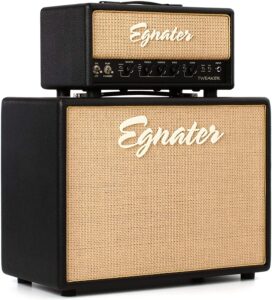
In 2009, my wife was involved in an automobile accident and we received a pretty nice chunk of change. She told me to go to Guitar Center and buy whatever guitar I wanted. I played the guitars I tried through an Egnater Tweaker 15 combo they had in the quiet room and I was smitten. It was a very versatile amp, and it could sound 90% of how I thought my DRRI sounded. In addition, it had a great built in drive sound, something my DRRI did not. I sold the DRRI and used that money to buy the Tweaker 15 head and cab.
That might have been 2010 and I only just sold that Tweaker head and cab in late ’22 or early ’23. In that 12 or 13 years, I never had a single issue with the amp. We recorded with it for the Lo-Fi, Nice Try and Cold the Winter albums. At some point, however, I realized that I liked Marshall-in-a-box pedals more than the Marshall tones in the Tweaker. I also wanted that last bit of Fender clean that the amp couldn’t do. That led me to my next purchase.
I eventually sold the Egnater Tweaker and used the funds to buy a Strymon Iridium pedal that served as an “amp” in the Egnater’s place.
2018 ’65 Fender Princeton Reverb Limited Edition
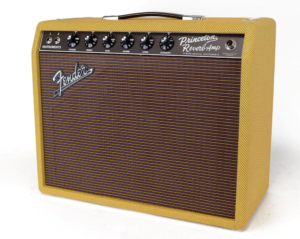 I reached out to my Sweetwater rep, a dude named Nich Magnani, and we talked about what I wanted. He suggested I check out a Princeton Reverb. I balked because I wanted a 12″ speaker, but he countered that they just so happened to have one with a 12″ speaker. Interestingly, that 12″ speaker is a Cannabis Rex, which I think sounds great. On top of that, it was in a tweed cabinet, just like the old ones. After a little more discussion, the amp was on its way home.
I reached out to my Sweetwater rep, a dude named Nich Magnani, and we talked about what I wanted. He suggested I check out a Princeton Reverb. I balked because I wanted a 12″ speaker, but he countered that they just so happened to have one with a 12″ speaker. Interestingly, that 12″ speaker is a Cannabis Rex, which I think sounds great. On top of that, it was in a tweed cabinet, just like the old ones. After a little more discussion, the amp was on its way home.
I’ve often referred to the Princeton Reverb as the 15-watt little brother of the Deluxe Reverb. Although the 7-watt difference really doesn’t impact the loudness of the amp, it does affect the headroom of it, which means the signal will naturally begin to breakup at a lower volume than the Deluxe Reverb does. That’s great for the studio, but not so great for some band situations if you want to keep your tone clean.
Needless to say, I loved it. I did run into an issue where there was a bit of a crackle on the 1st input, but that leveled out over time. Turns out the speaker just needed to be broken in.
Interestingly, I posted this on 8/31/23. At that time, I said “the Princeton Reverb is perfect, and remains in constant use as my “wet” signal amp. On Sunday, 9/3/23, an amp was posted for sale and I bought it on 9/4/23. Although the Mesa Express 5:25 I’ll talk about shortly ended the Princeton’s time as my “go to” amp, that purchase ended it’s time altogether.
I’d quickly suggest this, or any other Limited Edition with a 12″ speaker, ’65 Princeton Reverb, especially in a studio environment. I just don’t have the luxury of keeping a third amp anymore.
1978 Fender Vibro Champ
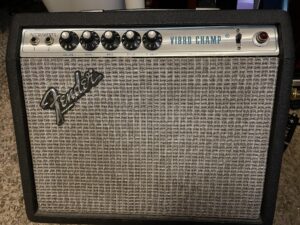 Not too long after buying the Princeton Reverb, I had the opportunity to buy a vintage, Silverface Fender Vibro Champ. I’d always wanted to own a guitar and amp from my birth year, and it was possible that this model WAS from 1978. I paid $500 for it, which was a fair price when I bought it.
Not too long after buying the Princeton Reverb, I had the opportunity to buy a vintage, Silverface Fender Vibro Champ. I’d always wanted to own a guitar and amp from my birth year, and it was possible that this model WAS from 1978. I paid $500 for it, which was a fair price when I bought it.
The Vibro Champ has an 8″ speaker and it’s pretty shrill, but it offered a nice contrast to my Princeton. I stuck an SM57 on it and it was used on every KCWM album and the “Go On” and “It Feels Familiar” singles.
Eventually, I began to feel disconnected from the Vibro Champ. I was able to sell it and use the funds to purchase of the next, and final amp.
Mesa Express 5:25
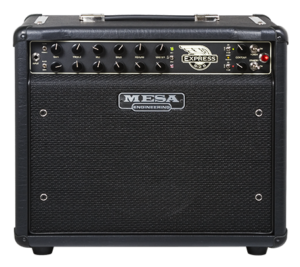 I’ve always been interested in Mesa/Boogie amps. Some friends of mine had a band and one of the dudes in that band played through one, some 4×10 model I can’t remember. It cut right through the mix in every show they played. While I owned a TA-15 head for a while, I only had it to sell/trade.
I’ve always been interested in Mesa/Boogie amps. Some friends of mine had a band and one of the dudes in that band played through one, some 4×10 model I can’t remember. It cut right through the mix in every show they played. While I owned a TA-15 head for a while, I only had it to sell/trade.
When someone was selling one on Facebook and agreed to sell it to me for what I sold the Vibro Champ for plus a Wampler Sovereign pedal, I pulled the trigger on it.
The amp has two channels with two options on each channel. Each channel has its own reverb and a contour control for final shaping of the tone, both of which are footswitchable. Needless to say, it’s versatile. One of the clean channel options actually sounds great as a drive, and one of the drive channel options works as a clean channel. I currently run the clean channel and drive channels as they are intended.
The Express 5:25 has replaced my Princeton Reverb as my go-to amp. As I consider a further move into combining the digital world using Amplitube 5 with my physical amps, I’m on the edge of selling the Princeton Reverb and just running everything through the Mesa. Thing is, I haven’t really messed with it as a pedal platform, though I imagine it’d be great.
I run the 5:25 in 5-watt mode and also use a JHS Black Box amp as a Master Volume in the effects loop.
Current Amps
2004 Dr. Z Maz 18 Jr.
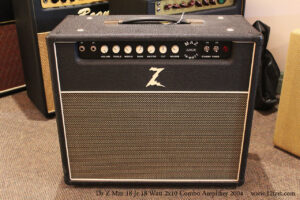 The Maz 18 is a popular “boutique” amp that’s point-to-point (PTP), or “hand-wired”. Many production amps use PCB, or printed circuit-board. PTP is more expensive up front, but can save money on costly repairs down the line.
The Maz 18 is a popular “boutique” amp that’s point-to-point (PTP), or “hand-wired”. Many production amps use PCB, or printed circuit-board. PTP is more expensive up front, but can save money on costly repairs down the line.
It’s a single channel, 18-watt amp with a pretty straightforward control setup. The Cut control adds an extra level of tone-shaping control that can be found on Vox amps, but not on the other amps I’ve owned.
I’m still very new to owning it, but it sounds amazing. Along with the Cut control, this amp has a Master control. I can get natural breakup with the Volume control but tame the overall loudness.
Edit: Since buying the Maz 18 in September of 2023, I have found it to be a reliable pedal platform for my drive pedals.
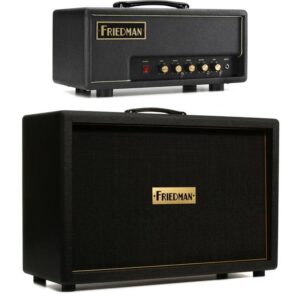 Friedman PT-20 v2 head and PT-112 cab
Friedman PT-20 v2 head and PT-112 cab
While I’m familiar with the Friedman name, I’ve never really followed the company’s amps and only followed the pedals at a distance.
The PT-20 v2 is a Marshall-esque amp styled after the JCM800. I have long favored Marshall-in-a-box pedals like the Zvex Double Rock, Wampler Pinnacle, and Catalinbread Dirty Little Secret Deluxe as a drive sound. Having the amount of gain available in this little 20-watt package is going to be an interesting experience to explore.
Just from my brief experience with this amp, it’s a very loud 20 watts, but there’s a bite and crispness to the sounds produced by the amp that I like. Even at similar volumes, it kind of cuts over the Maz 18, which is a bit of a surprise.
I haven’t decided if I’m going to keep the PT-20 as the “dry” amp in my dual-amp setup or move my Radial Engineering Twin City to the end of my pedal chain to run my pedals out to both amps.
I guess that means I’ll have to experiment and test out both possibilities. Man, what a burden.
There you have it. A long, lengthy journey across my “main” amps over the years, from about 1994 to 2023.

